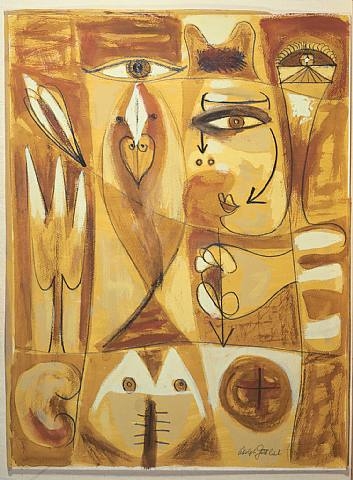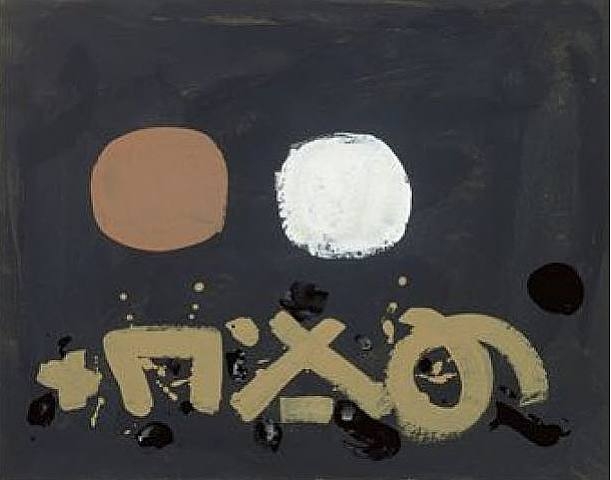In Arizona, his subject matter changed as he became concerned with the natural forms that would continue to mark all of his subsequent work. A feeling of isolation prompted his return to New York in 1939 and from there he went to Gloucester where he began to paint beach still-lives in three-dimensional boxes set against deeply receding spaces. He soon abandoned this form, but these experiments led to his pictographs of the forties-stylized motifs based on human and natural forms isolated in compartments. For Gottlieb the pictographs were his adaptation of Surrealist automatism-the result of free association. Later, he would reduce these pictographs to an increasingly basic structure: the grid. The next step occurred in a painting divided into two parts: in the lower section he placed the interwoven lines of a grid; on top of this he drew a horizon line above which floated five areas of colour in varying geometric shapes. This was the first of a series to be known as ‘Imaginary Landscapes’.
As Gottlieb's structures became simpler he became increasingly concerned with the intensity, nuance and feeling inherent in the juxtaposition of colour.
Gottlieb spent the last part of his life in East Hampton, Long Island, amid the natural things that gave him the greatest inspiration. He suffered from paralysis during the last years of his life and died in 1973.
 |
| 1937 The Natural Swimming Pool |
1938 Untitled (Arizona Still Life)
1943 Black Hand
1945 The Alchemist
1947 Untitled
1948 Figures
1949 Untitled F3
1950 Night Forms
1951 Sentinel
1956 From Midnight to Dawn
1956 Untitled (5633)
1967 Figure Eight
1967 Jetsam
1967 Mood
1967 Untitled
1968 Untitled
 |
| 1969 Green Dream serigraph |
 |
| 1969 Imaginary Landscape |
 |
| 1969 Three Discs on Chrome Ground |
 |
| 1971 Blues on Green screenprint |
1971 Imaginary Landscape II aquatint
1973 Calligraphy (7315)
1973 Untitled
1973 Untitled
































No comments:
Post a Comment
Note: only a member of this blog may post a comment.